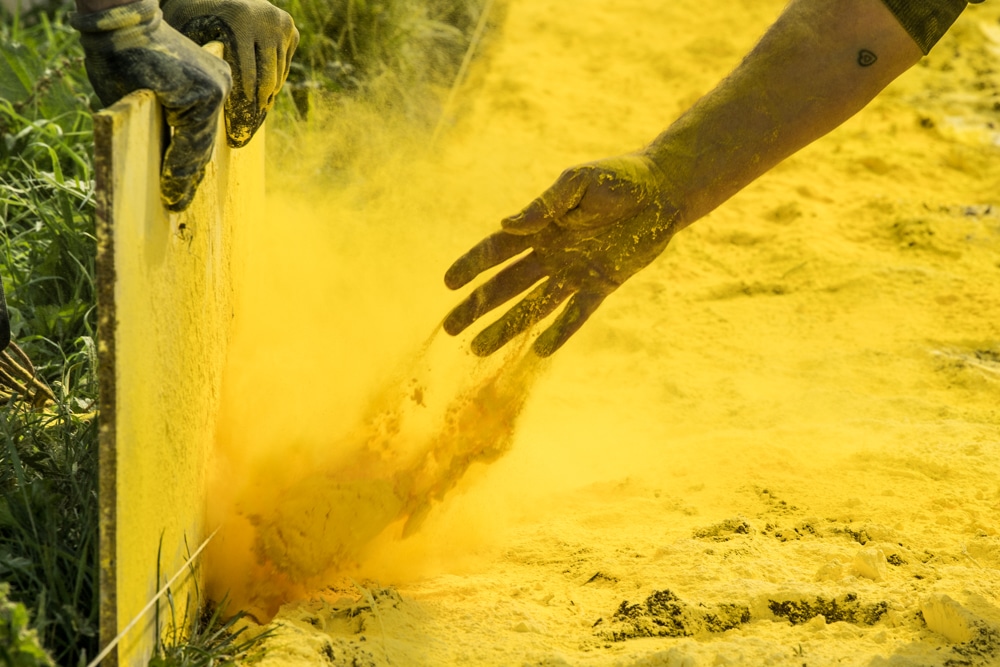
What Is Across and In-Between?
Across and In-Between is a two-part artwork, we call each of these parts The Yellow Line and the Border People’s Parliament.
The Yellow Line is a three-screen film projection we made with communities of farmers, dancers, horse-owners, scouts and hikers at border locations. A collective act in drawing a line on a landscape. It is a creative act of play giving border people an opportunity to own the frontier, draw it and erase it.
We are also inviting participants to a private event, the Border People’s Parliament in Stormont’s Parliament Buildings during the festival. Here we’re both celebrating their involvement in the project but also engaging them in a series of recorded discussions responding to questions that have repeatedly arisen over the course of the project. This will end in the publication of their own set of principles based on things we can learn from life in Ireland’s borderlands.
- Who is Suzanne Lacy?
Suzanne is an American artist whose work has been exhibited around the world from Tate Modern to the Whitney in New York. She was formative in the latter half of the 20th century in shaping an emergent art of social engagement which is exactly why we wanted to work with her. Communities and participation are central to the work she makes, often around complex subjects. We wanted to take someone with an outsider’s eye to the border in Ireland but with the ability to deeply engage with communities to make something involving them about their lives in such a landscape. Suzanne brings a unique point of view to an issue that has global implications but also impacts on a local level.
- How did we do it?
In the first half of 2018, Suzanne Lacy and the Across and In-Between team journeyed across Ireland’s borderlands, from Carlingford in the south-east to Derry-Londonderry in the north-west. We ended up working mostly around the border’s middle stretch, at some of the most isolated places between Pettigo in Co. Donegal and Newtownbutler in Co. Fermanagh.
Along the way we recorded scores of interviews with people about their daily lives and their relationship to the landscape around them. We talked to them about the impact of drawing lines in landscapes and how, in the professional or social life they lead, those lines impact upon them. Then, inspired by the yellow gorse hedgerows seen everywhere along the border counties, we drew yellow lines with them across border landscapes on film, using the occupations or hobbies they pursue. This became The Yellow Line which we’re showing outside the Ulster Museum during Festival.
We’ve also been documenting the entire process through film, sound and photography, all produced by local artists: collecting interviews and conversations, photographing the participants and their collaborative productions along the border. This, with the Border People’s Parliament will form part of a wider conversation about life in a border landscape.
- What inspired the commissioning of the project?
One hundred years ago, the border existed only as a proposition, an imaginary line ready to be drawn. From 1922 on it was present in one way or another, visibly so during the Troubles. Today, after the Good Friday Agreement of 1998, the border exists but is almost invisible. With the Brexit vote, we face the possibility that it will be made visible again, that the border will have a demanding physical presence again. We wanted to revisit the idea of drawing, of the impact of lines visible or invisible and felt there was some power in giving residents ownership of that line, it is their home after all. At least, we wanted to engage them in an action that would allow them to talk about it in the context of the lives they lead.
- When can we see it?
During Festival the work is both being completed and part of it presented. We’re still making it through the Border People’s Parliament, an amazing opportunity for our Yellow Line participants to be involved in a performance led by Suzanne during the festival. But, for the public, you will get to see the product of their hard work with us along the border, a massive three-screen projection across the front of the Ulster Museum – The Yellow Line. It will be on from 6pm to 9pm every night from Thursday 18 – Tuesday 23 October. There will also be some of our documentary interview footage available to view on site, giving an insight into some of the conversations the project led to along the way.